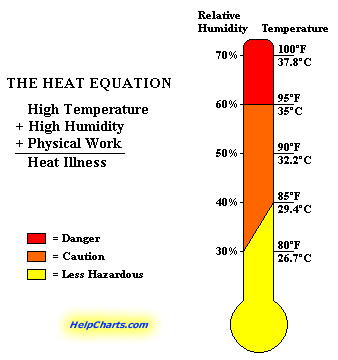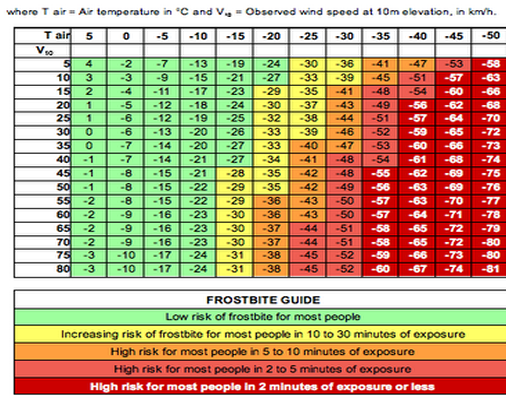Extreme Temperatures and Your Health
Familiarize yourself with these terms to help identify an extreme heat hazard:
Heat Wave
Prolonged period of excessive heat, often combined with excessive humidity.
Heat Index
A number in degrees Fahrenheit (F) that tells how hot it feels when relative humidity is added to the air temperature. Exposure to full sunshine can increase the heat index by 15 degrees.
Heat Cramps
Muscular pains and spasms due to heavy exertion. Although heat cramps are the least severe, they are often the first signal that the body is having trouble with the heat.
Heat Exhaustion
Typically occurs when people exercise heavily or work in a hot, humid place where body fluids are lost through heavy sweating. Blood flow to the skin increases, causing blood flow to decrease to the vital organs. This results in a form of mild shock. If not treated, the victim's condition will worsen. Body temperature will keep rising and the victim may suffer heat stroke.
Heat Stroke
A life-threatening condition. The victim's temperature control system, which produces sweating to cool the body, stops working. The body temperature can rise so high that brain damage and death may result if the body is not cooled quickly.
Sun Stroke
Another term for heat stroke.
The following preventative measures can help you to avoid heat related injuries.
1) Drink plenty of fluids. In hot environments, it is possible for the body to loose one liter of fluids per hour. Thirst is not a good indicator of fluid loss. Don't wait until you are thirsty to drink fluids.
2) Be aware of your environment. If you work in the heat or around heat sources, take whatever steps are possible to control the heat externally.
3) Take frequent breaks. As the temperature increases, more frequent breaks are needed to stay cool.
4) Wear proper clothing. Loose, lightweight fabrics encourage heat release. Acclimatize. It takes at least 7-10 days to get used to working in a hot environment.
5) Stay in shape. A healthy heart and good muscle tone work more efficiently and generate less heat.
6) Eat light during the workday. Hot, heavy meals add heat to the body and divert blood flow to aid with digestion. Normal dietary intake typically replaces all salt lost during the day, so there is no need to take salt supplements.
7) Be aware of special heat stress risk. Caffeine, alcohol, diabetes, or medications for high blood pressure and allergies can increase the risk of heat stress.
When the body is unable to cool itself through sweating, serious heat illness may occur. The most severe heat-induced illnesses are heat exhaustion and heat stroke. If action is not taken to treat heat exhaustion, the illness could progress to heat stroke and possible death. The following are symptoms and treatments for these heat related illnesses:
Symptoms of Heat Exhaustion
Headaches, dizziness/Lightheadedness, weakness, mood changes (irritable or confused/can't think straight), feeling sick to your stomach, vomiting/throwing up, decreased and dark-colored urine, fainting/passing out, pale and clammy skin.
Treatment: Move the person to a cool, shaded area to rest. Don't leave the person alone. If the person is dizzy or light headed, lay them on their back and raise their legs about 6-8 inches. If the person is sick to their stomach, lay tem on their side. Loosen and remove any heavy clothing. Have the person drink some cool water (a small cup every 15 minutes) if they are not feeling sick to the stomach. Try to cool the person by fanning them. Cool the skin with a cool spray mist of water or wet cloth. If they do not feel better in a few minutes, call for emergency help (ambulance or 911).
If heat exhaustion is not treated, the illness may advance to heat stroke.
Symptoms of Heat Stroke – A medical emergency
Dry, pale skin (no sweating), hot, red skin (looks like a sunburn), mood changes (irritable, confused/not making any sense), seizures/fits; collapse/passed out (no response).
Treatment: Call for emergency help (ambulance or 911). Move the person to a cool shaded area. Don't leave the person alone. Lay them on their back, and if the person is having seizures/fits, remove any object close to them so they won't strike against them. If the person is sick to their stomach, lay them on their side. Remove any heavy and outer clothing. Have the person drink some cool water (a small cup every 15 minutes) if they are alert enough to drink anything and not feeling sick to the stomach. Try to cool the person by fanning them. Cool the skin with a cool spray mist of water, wet cloth, or wet sheet. If ice is available, place ice packs under the armpits and groin area.

Wind Chill and Frostbite Chart


